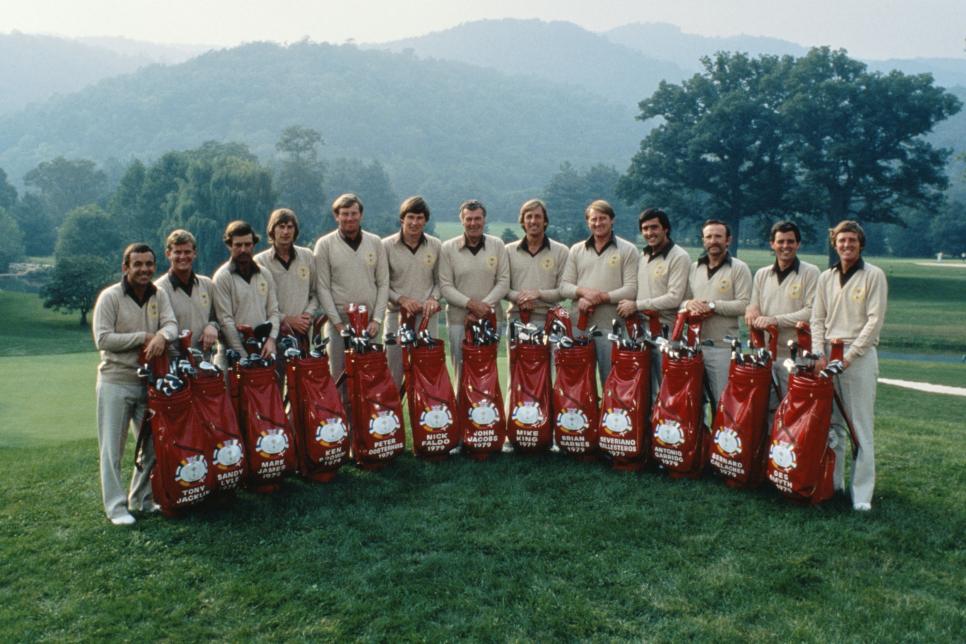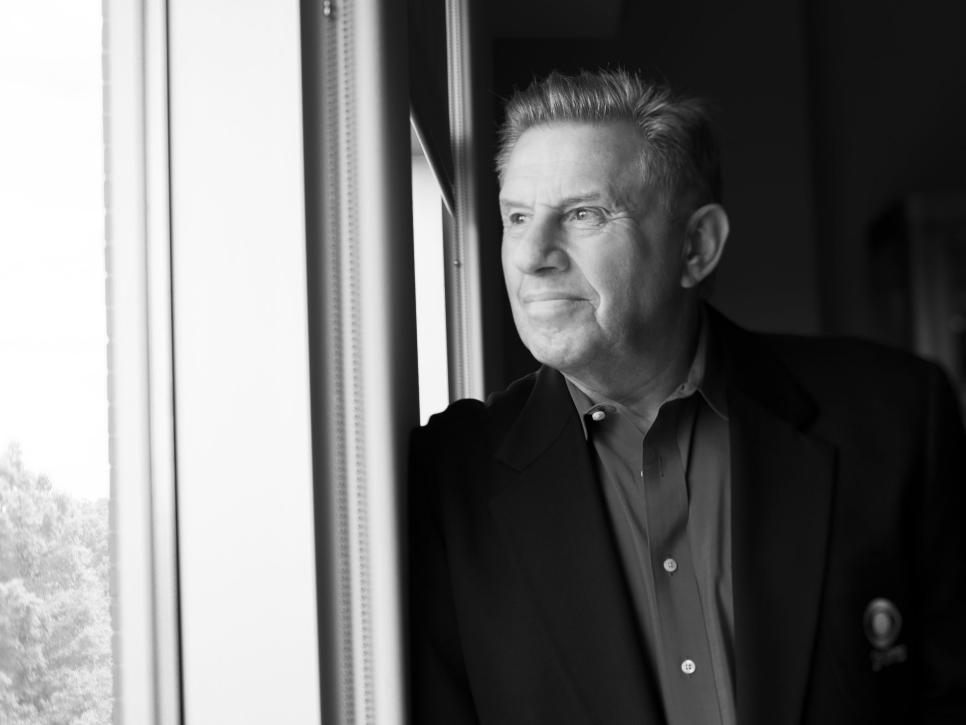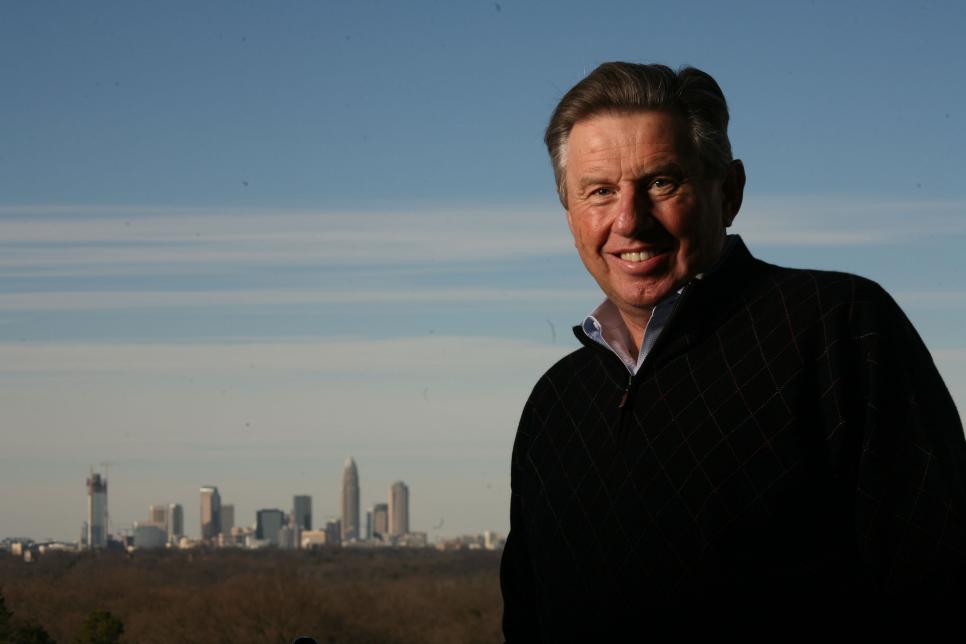[PHOTO: Dom Furore]
Peter Oosterhuis made people comfortable. He was a flinty but friendly competitor, an authoritative but empathetic broadcaster, a stimulating but relaxing dinner companion. His gift for counterbalance allowed him to leaven even the horrible experience of Alzheimer’s disease.
The urbane Englishman’s life well lived ended peacefully early last Thursday morning in his long-time home of Charlotte in North Carolina, one day short of his 76th birthday, after a decade of contending with the effects of the illness that steals so much.
But according to his wife of 31 years, Ruthie Oosterhuis, her husband retained a vital part of his personality. “When specialists in Houston were treating Peter when the disease was starting to progress, one told us, ‘Peter is always going to be happy,’” she recounted. “I asked, ‘How can you know that?’ And he said, ‘Because Peter is a very happy person.’ And as awful as the disease can be, that proved to be true.”
Said his longtime CBS colleague Ian Baker-Finch: “Peter Oosterhuis was one of the kindest gentlemen I’ve ever known, maybe the kindest. Never had a cross word. Always a smile. After he was diagnosed, he didn’t dwell on what lay ahead. He’d just say something like, ‘I’m sure the boss (Ruthie) will look after me. She’ll make sure everything’s good.’ Then he’d chuckle the way he did. He was never down.”
That endearing cheerfulness, along with a modesty that belied his considerable achievements, must have been discernible to not just those who knew him, but through the television screen. “There is nothing about my life in golf I want to forget,” Oosterhuis told Golf Digest’s Guy Yocom in 2015 after retiring and going public with his condition. “It’s all been good.”
In his playing career, Oosterhuis won the then-European Tour’s Order of Merit four straight times in the early 1970s. With a short backswing designed to regulate the long levers of his 6-foot-5 frame, he won 20 times worldwide, with seven official victories in Europe and one on the PGA Tour, outduelling Jack Nicklaus down the stretch of the 1981 Canadian Open.
Along the way, he came very close to having a storied career, finishing second twice in the Open Championship, in 1974 by four strokes to Gary Player, and in 1982 by a stroke to Tom Watson. In 1973, he led the Masters by three strokes after 54 holes, but was undone by a bogey on the par-5 15th and finished tied for third. Most notably, he was a Ryder Cup stalwart during years when the Americans badly overmatched the Great Britain & Ireland team. In six matches from 1971 to 1981, Oosterhuis compiled a 14-11-3 record, including two wins against Arnold Palmer, and his six singles wins remain in a tie for the most by any player.

“We were the two tallest, with sweaters that were too short, so they put us together,” Faldo said. “But we gelled so well. Peter was a seasoned campaigner, and a great putter. I was the eager kid. He was quietly not afraid of anyone, and that rubbed off. In our first match [against Raymond Floyd and Lou Graham], we were 3 down at the turn but won, 2&1. Afterward, Oosty asked me, ‘Were you afraid we were going to lose?’ I thought and said, ‘No.’ He said, ‘Nor was I.’ The next day we beat Floyd and Jack Nicklaus. Peter had that calm, confident outlook that gave you the feeling that everything was possible.”
When his competitive career ended in the late 1980s, Oosterhuis transitioned to television with surprising ease. After his father escaped the Nazi occupation of Holland during World War II, Oosterhuis was born and raised in London and educated at venerated Dulwich College, where P.G. Wodehouse had developed the literary skills that would translate to the funniest golf stories ever written. Oosterhuis found that losing himself in studies could ease anxiety from chronic OCD, and he did the same with his preparation for telecasts, which informed his commentary with detail and nuance.




“Peter was a player’s announcer,” says Frank Nobilo, who worked with Oosterhuis at Golf Channel and followed him at CBS. “He’d tell the viewer what they didn’t know, whether it was about a shot or what might be going through a player’s head, but never made himself the centre of the call. At work, in his life, he was nothing but graceful.”
“There was a tenderness to his tone,” said Jim Nantz, with whom Oosterhuis worked with on the CBS team for 18 years. “If a player was making a mess of a hole, you’d hear the empathy in his voice, maybe a nervous giggle. To ease the pain. To help make everyone comfortable. But when a big moment came up, like Tiger’s par putt on the 71st hole at Medinah in 1999 – which we now know as one of the most important of his career – Peter would rise to the occasion. That call had real weight to it.”
Nantz was deeply affected when Oosterhuis was first diagnosed in July 2014. Nantz’s father had been afflicted with the disease for 13 years before passing away in 2008, leading to the Nantz National Alzheimer Center at Houston Methodist Neurological Center being founded three years later. It was at a fundraiser for the centre at Pebble Beach a few months after Oosterhuis retired that Peter took the microphone to publicly reveal that he had the disease. Oosterhuis was treated by specialists at the Nantz centre, but his condition had progressed too far for new drugs to significantly help. “There was a game plan for Peter,” said Nantz, “but unfortunately it couldn’t prevent him from entering that dark world.”
For Ruthie Oosterhuis, her husband continued to give off light. “He always recognised me, knew me to the end,” she said. “When I walked in the room, his eyes would brighten. Each time I held his hand and said, ‘I love you’, he would answer, ‘I love you, too.’
“Peter loved so many things. Birdwatching, cataloging the hundreds of different species he saw on golf courses all over the world. Fine dining. Our life on the road, among his friends, to still be connected to the game he loved. He was living the dream. And when it ended, he was a man for all seasons.”




